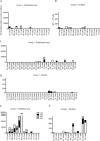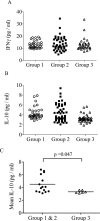Rapid early innate control of hepatitis C virus during IFN-α treatment compromises adaptive CD4+ T-cell immunity
- PMID: 22653709
- PMCID: PMC3781703
- DOI: 10.1002/eji.201142072
Rapid early innate control of hepatitis C virus during IFN-α treatment compromises adaptive CD4+ T-cell immunity
Abstract
The ability to control HCV with IFN-α-based treatments provides an opportunity in humans to study how the rate of viral clearance in vivo impinges on the development of antiviral responses. Ex vivo (IFN-γ-producing) and cultured antiviral CD4(+) T cells, serum cytokines, and viral loads were measured repeatedly in a cohort of chronically HCV-infected subjects (n = 33) receiving IFN-α. Rapid control of virus indicated by an increased calculated rate of virus clearance, occurred in those subjects demonstrating absent/minimal T-cell responses (p < 0.0006). Surprisingly, in subjects who demonstrated the most robust T-cell responses (and reduced serum IL-10), there was actually a reduced rate of early virus clearance. A subsequent analysis of NK-cell function in available subjects (n = 8) revealed an inverse correlation between pretreatment NK-cell expression of NKp46 and the potential to upregulate cytotoxic function on exposure to IFN-α (p < 0.004), as well as the subsequent measured rate of viral clearance (p = 0.045). Thus, the CD4(+) T-cell response during IFN-α treatment appears to be shaped by the rate of innate virus suppression. These data suggest that individuals who respond most effectively to immune intervention may be most in need of subsequent vaccination to prevent reinfection.
© 2012 WILEY-VCH Verlag GmbH & Co. KGaA, Weinheim.
Figures




Similar articles
-
Hepatitis C virus-specific T-cell reactivity during interferon and ribavirin treatment in chronic hepatitis C.Gastroenterology. 2000 Feb;118(2):346-55. doi: 10.1016/s0016-5085(00)70217-4. Gastroenterology. 2000. PMID: 10648463 Clinical Trial.
-
Concomitant augmentation of type 1 CD4+ and CD8+ T-cell responses during successful interferon-alpha and ribavirin treatment for chronic hepatitis C virus infection.Hum Immunol. 2003 May;64(5):497-504. doi: 10.1016/s0198-8859(03)00041-7. Hum Immunol. 2003. PMID: 12691700
-
Both Hepatitis C Virus-Specific T Cell Responses and IL28B rs12979860 Single-Nucleotide Polymorphism Genotype Influence Antihepatitis C Virus Treatment Outcome in Patients with Chronic Hepatitis C.J Interferon Cytokine Res. 2017 Jun;37(6):278-286. doi: 10.1089/jir.2016.0078. Epub 2017 Apr 25. J Interferon Cytokine Res. 2017. PMID: 28440692
-
Chronic hepatitis C in the advanced adult and elderly subjects.Minerva Gastroenterol Dietol. 2009 Jun;55(2):145-57. Minerva Gastroenterol Dietol. 2009. PMID: 19305374 Review.
-
Control of HCV Infection by Natural Killer Cells and Macrophages.Cold Spring Harb Perspect Med. 2020 Sep 1;10(9):a037101. doi: 10.1101/cshperspect.a037101. Cold Spring Harb Perspect Med. 2020. PMID: 31871225 Free PMC article. Review.
Cited by
-
Rapid innate control of antigen abrogates adaptive immunity.Immunology. 2013 Apr;138(4):293-7. doi: 10.1111/imm.12048. Immunology. 2013. PMID: 23198899 Free PMC article. Review.
-
Antigen-Specific CD4+CD8+ Double-Positive T Cells Are Increased in the Blood and Spleen During Ehrlichia chaffeensis Infection in the Canine Host.Front Immunol. 2018 Jul 11;9:1585. doi: 10.3389/fimmu.2018.01585. eCollection 2018. Front Immunol. 2018. PMID: 30050533 Free PMC article.
-
Dendritic cell co-stimulatory and co-inhibitory markers in chronic HCV: an Egyptian study.World J Gastroenterol. 2013 Nov 21;19(43):7711-8. doi: 10.3748/wjg.v19.i43.7711. World J Gastroenterol. 2013. PMID: 24282359 Free PMC article.
-
Selective reconstitution of IFN‑γ gene function in Ncr1+ NK cells is sufficient to control systemic vaccinia virus infection.PLoS Pathog. 2020 Feb 5;16(2):e1008279. doi: 10.1371/journal.ppat.1008279. eCollection 2020 Feb. PLoS Pathog. 2020. PMID: 32023327 Free PMC article.
-
The paradox of NKp46+ natural killer cells: drivers of severe hepatitis C virus-induced pathology but in-vivo resistance to interferon α treatment.Gut. 2014 Mar;63(3):515-24. doi: 10.1136/gutjnl-2013-304472. Epub 2013 May 11. Gut. 2014. PMID: 23665989 Free PMC article.
References
-
- Randall RE, Goodbourn S. Interferons and viruses: an interplay between induction, signalling, antiviral responses and virus countermeasures. J. Gen. Virol. 2008;89:1–47. - PubMed
-
- Thursz M, Yallop R, Goldin R, Trepo C, Thomas H. Influence of MHC class II genotype on outcome of infection with hepatitis C virus. Lancet. 1999;354:2119–2124. - PubMed
-
- Botarelli P, Brunetto M, Minutello M, Calvo P, Unutmaz D, Weiner A, Choo Q, et al. T-lymphocyte response to hepatitis C virus in different clinical courses of infection. Gastroenterology. 1993;104:580–587. - PubMed
-
- Cramp M, Rossol S, Chokshi S, Carucci P, Williams R, Naoumov N. Hepatitis C virus-specific T-cell reactivity during interferon and ribavirin treatment in chronic hepatitis C. Gastroenterology. 2000;118:346–355. - PubMed
Publication types
MeSH terms
Substances
Grants and funding
LinkOut - more resources
Full Text Sources
Research Materials

